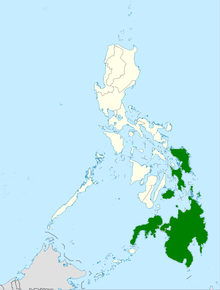| This article may require cleanup to meet Misplaced Pages's quality standards. The specific problem is: most material can probably be sourced to the provided sources, but for whatever reason they are all bunched up in the lede. Need to be distributed to the sections they actually belong to. Please help improve this article if you can. (April 2021) (Learn how and when to remove this message) |
| Samar cobra | |
|---|---|

| |
| Conservation status | |
 Least Concern (IUCN 3.1) | |
| CITES Appendix II (CITES) | |
| Scientific classification | |
| Domain: | Eukaryota |
| Kingdom: | Animalia |
| Phylum: | Chordata |
| Class: | Reptilia |
| Order: | Squamata |
| Suborder: | Serpentes |
| Family: | Elapidae |
| Genus: | Naja |
| Species: | N. samarensis |
| Binomial name | |
| Naja samarensis Peters, 1861 | |

| |
| Distribution of the Samar cobra | |
The Samar cobra (Naja samarensis) also called Peters' cobra, southern Philippine cobra or Visayan cobra, is a highly venomous species of spitting cobra native to the Visayas and Mindanao island groups of the Philippines.
Description
The Samar cobra is a species of spitting cobra that can grow up to 1.4 meters in length. Their coloring varies from a black and yellow to green.
Scalation
There are 17-25 scale rows around the hood, 17-19 ahead of mid-body; 161-184 ventrals, 41-52 subcaudals, basal pairs sometimes undivided.
Reproduction
The Samar cobra, or southeastern Philippines cobra, is oviparous, laying clutches of up to eight eggs.
Distribution and habitat
The Samar cobra is endemic to the southern Philippines. Specifically, the Visayas and Mindanao island groups.
Habitat can vary widely from mountainous jungle to tropical plains. They can live close to human settlements.
The Samar cobra typically lives at an elevation of 0 - 1,000 m (0 - 3,280 feet) asl.
Behavior and diet
Like the Philippine cobra (Naja philippinensis), the Samar cobra feeds mostly on small rodents such as rats and mice. They will also prey upon frogs and smaller reptiles. Since their main food source is attracted to rice paddies and human settlements, this species often comes into conflict with people.
Venom
A proteomic study revealed a unique venom phenotype of the Samar cobra, which represents the easternmost dispersal of Naja cobra species. Like other Naja spp., Three-finger toxins (3FTx) dominate the venom proteome. 3FTx constituted 90% of the total venom proteins, recording by far the highest 3FTx abundance in snake venom. Other proteins in the venom comprised snake venom metalloproteinases (SVMP, 4.17%) and phospholipases A2 (PLA2 3.76%). The rest of minor toxins collectively accounted for <2% of total venom proteins; these were toxin families of cysteine-rich secretory protein (CRiSP, 1.06%), L-amino acid oxidase (LAAO, 0.26%), venom nerve growth factor (vNGF, 0.13%) and vespryn (VES, 0.13%). The crude venom of N. samarensis has LD50 of 0.2mg/kg via intravenous injection (IV). They are noted for their nervous behavior, and are quick to strike as well as to spray venom, which they generally aim towards the face and eyes. However, the cobra is more reluctant to spit venom than its northern relative, the Northern Philippines cobra. If venom gets in the eyes, it causes extreme pain and mechanical damage to the eyeball. If not properly flushed out, it can result in permanent blindness due to its tissue destroying properties.
References
- Sy, E.; Custodio, C.; Gonzalez, J.C.; Delima, E.M. (2009). "Naja samarensis". IUCN Red List of Threatened Species. 2009: e.T169763A6670726. doi:10.2305/IUCN.UK.2009-2.RLTS.T169763A6670726.en. Retrieved 11 November 2021.
- "Appendices | CITES". cites.org. Retrieved 2022-01-14.
- "Naja samarensis". ITIS Standard Report Page. ITIS.gov. Retrieved 10 January 2012.
- "Naja samarensis PETERS, 1861". Taxonomy of Elapids. Reptile-Database. Retrieved 10 January 2012.
- "Naja samarensis, General Details, Taxonomy and Biology, Venom, Clinical Effects, Treatment, First Aid, Antivenoms". WCH Clinical Toxinology Resource. University of Adelaide. Retrieved 10 January 2012.
- "Naja samarensis - Southeastern Philippine Cobra". Asiatic Naja. Bangor University. Retrieved 5 November 2013.
- Dart, Richard C (2003). Medical Toxicology. USA: Lippincott Williams & Wilkins; 3 edition. p. 1569. ISBN 0-7817-2845-2.
- Brown, John Haynes (1973). Toxicology and Pharmacology of Venoms from Poisonous Snakes. Springfield, Illinois, USA: Charles C. Thomas. pp. 81. ISBN 0-398-02808-7.
- Zug, George R. (1996). Snakes in Question: The Smithsonian Answer Book. Washington D.C., USA: Smithsonian Institution Scholarly Press. ISBN 1-56098-648-4.
- "Naja samarensis". University of Adelaide.
- Wüster, W.; Thorpe, R. S. (1991). "Asiatic cobras: Systematics and snakebite". Experientia. 47 (2): 205–9. doi:10.1007/BF01945429. PMID 2001726. S2CID 26579314.
- "Bangor University".
- Palasuberniam, Praneetha; Chan, Yi Wei; Tan, Kae Yi; Tan, Choo Hock (2021). "Snake Venom Proteomics of Samar Cobra (Naja samarensis) from the Southern Philippines: Short Alpha-Neurotoxins as the Dominant Lethal Component Weakly Cross-Neutralized by the Philippine Cobra Antivenom". Frontiers in Pharmacology. 12: 3641. doi:10.3389/fphar.2021.727756. ISSN 1663-9812. PMC 8740184. PMID 35002690.
| Taxon identifiers | |
|---|---|
| Naja samarensis | |